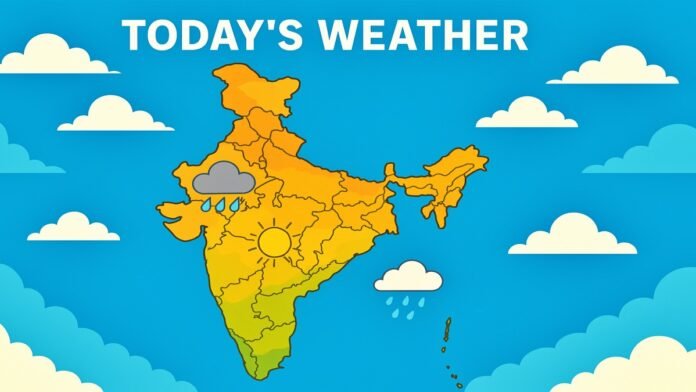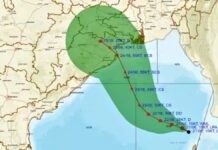
Key Points:
- Severe Cyclonic Storm Montha made landfall near Kakinada, Andhra Pradesh on October 28, 2025, with wind speeds up to 100 kmph and gusts reaching 110 kmph
- At least two people have been confirmed dead in Andhra Pradesh, with crops destroyed across 87,000 hectares and 380 kilometers of roads damaged
- The cyclone has weakened into a deep depression but continues to cause heavy rainfall across Bihar, Uttar Pradesh, Jharkhand, and other states until October 31, 2025
- IMD has issued red alerts for 20 districts in Bihar and warnings for 17 districts in eastern Uttar Pradesh on October 30-31
- Delhi-NCR experiencing light fog, clouds, and cold winds with predicted light rain on October 30, while temperatures are expected to drop further from November 1
- Nearly 1.8 lakh people were evacuated to relief camps in Andhra Pradesh, with 219 medical camps and 865 tonnes of animal fodder arranged
New Delhi: The weather across India has taken an unexpected and dramatic turn in the final days of October 2025, as Cyclone Montha disrupts normal patterns from South India to the northern plains. The severe cyclonic storm, named by Thailand and meaning “fragrant flower,” made landfall between Machilipatnam and Kalingapatnam near Kakinada on Tuesday evening, October 28, bringing widespread destruction and triggering a cascade of weather changes across multiple states. The India Meteorological Department (IMD) has issued warnings for heavy to very heavy rainfall in several states through October 31, with the cyclone’s remnants continuing to influence weather patterns across eastern and northern India.
Devastating Impact in Andhra Pradesh
Cyclone Montha wreaked havoc in Andhra Pradesh, where it claimed at least two lives and caused extensive damage to infrastructure and agriculture. According to Andhra Pradesh Chief Minister N. Chandrababu Naidu, who conducted an aerial survey of affected areas, including Bapatla, Palnadu, Krishna, Konaseema, and Eluru, crops spread across 87,000 hectares, including paddy, maize, cotton, and black gram, have been damaged in 304 mandals. The storm also destroyed 380 kilometres of roads and 14 bridges, affecting nearly 79,000 farmers due to severe waterlogging.
A woman died at Makanagudem village in Konaseema district when an uprooted palmyra tree fell on her during the gales, highlighting the storm’s deadly potential. Nearly 1.8 lakh (180,000) people were shifted to relief camps, while the government arranged 219 medical camps at various locations and 865 tonnes of animal fodder to support affected communities.
High Alert in Bihar and Uttar Pradesh
The remnants of Cyclone Montha are significantly impacting Bihar and Uttar Pradesh, with the IMD issuing alerts for heavy rain and strong winds. The Patna Meteorological Department has warned of heavy rainfall and gusty winds in 20 districts of Bihar on October 30-31, with districts like Darbhanga, Muzaffarpur, and Buxar expected to be particularly affected. The IMD has forecast very heavy rainfall in Bihar, Saurashtra, and Kutch regions until October 31, 2025.
In Uttar Pradesh, the Meteorological Department has issued warnings for heavy rain in 17 districts of the eastern region on October 30. Heavy rain and thunderstorms are expected in Varanasi, Prayagraj, Mau, Jaunpur, and Ghazipur, while light rain may also occur in parts of Lucknow and Kanpur. The increased rainfall has led to a sudden drop in temperatures, bringing an early onset of winter-like conditions.
Delhi-NCR Weather Changes
The weather in Delhi-NCR has also been affected by Cyclone Montha’s influence on broader atmospheric patterns. Light fog and clouds have been observed since Thursday morning, October 30, with cold winds increasing the chill factor. The Meteorological Department has predicted light rain in Delhi on October 30, which is expected to lower temperatures further. The cold is anticipated to intensify from November 1 onwards, marking a transition from the mild autumn weather to winter conditions.
Other North Indian states, including Haryana, Punjab, and Eastern Rajasthan, are also experiencing cloudy weather, with light to moderate rain possible on October 30. This widespread weather change has brought an abrupt end to the pleasant autumn conditions that typically characterize late October in northern India.
Jharkhand Experiences December-Like Cold
Torrential rains in Jharkhand have brought premature December-like cold conditions to the state. The Ranchi Meteorological Department has warned of heavy rainfall in districts including Chatra, Palamu, Khunti, and Gumla until October 31. The sudden temperature drop has caught residents off guard, as the state transitions from relatively warm autumn weather to winter-like conditions within days.
Eastern India Braces for Impact
In West Bengal, heavy rain and lightning are expected in Howrah, Kolkata, and Darjeeling districts. The IMD has forecast very heavy showers in sub-Himalayan West Bengal and Sikkim on Friday, November 1. In neighboring Odisha, normal life was affected in 15 districts as the cyclone crossed the coast, with Chilika Lake turning turbulent and heavy rain inundating Rayagada and other southern districts.
The cyclone’s landfall triggered high tidal waves that damaged the Uppada-Kakinada beach road in Andhra Pradesh, forcing authorities to close it for traffic. Great danger signal number 10, the highest danger signal issued to ports during severe cyclones, was hoisted at Kakinada Port, while signal number nine was raised at Visakhapatnam, Gangavaram, Kalingapatnam, and Bheemunipatnam ports.
Continued Storm Activity in South India
Despite weakening to a deep depression over coastal Andhra Pradesh and Telangana by Wednesday, October 29, the storm continues to cause significant disruption in southern states. The cyclonic storm moved north-northwestwards at 15 kmph and was positioned near latitude 17.0°N and longitude 81.3°E at 5:30 AM on October 29, located 80 km northwest of Narsapur, 100 km west of Kakinada, and 90 km north of Machilipatnam.
Winds of up to 65 km/h continue to gust along the coasts of Tamil Nadu, Karnataka, and Odisha. The Warangal railway station in Telangana was flooded, while Chennai schools were closed for one day due to flooding, with the Greater Chennai Corporation setting up 215 relief centers and 106 central kitchens to support residents in flood-prone areas. The IMD has strongly advised fishermen not to venture into the sea along the eastern coast until conditions improve.
Central and Northeastern States Under Watch
Rainfall is also expected in eastern Madhya Pradesh, Vidarbha, Marathwada, and Chhattisgarh until October 31. The IMD has forecast very heavy rainfall along coastal Andhra Pradesh and Yanam, Rayalaseema, Vidarbha, and Marathwada on Wednesday, October 30. Northeastern states, including Arunachal Pradesh, Assam, and Meghalaya, are expected to experience light to moderate rainfall between October 31 and November 1.
Transportation and Infrastructure Disruption
The cyclone has caused major disruption to railway services across eastern India. Indian Railways cancelled, diverted, and rescheduled multiple coaching trains across the Waltair Division of East Coast Railway Zone on Tuesday, while the South Central Railway (SCR) Zone cancelled 120 trains in total on Monday and Tuesday. Power outages have been reported across Andhra Pradesh, with transportation networks severely affected by flooding and damaged roads.















































